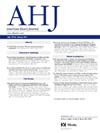The randomized controlled trial to compare temporary permanent pacemaker vs temporary pacemaker in patients with conduction block after transcatheter aortic valve replacement: Rationale and design of the RECOVER trial
IF 3.7
2区 医学
Q1 CARDIAC & CARDIOVASCULAR SYSTEMS
引用次数: 0
Abstract
Rationale
Current guidelines and expert consensus recommend different time thresholds of temporary pacemaker (TM) indwelling in patients with conduction block after transcatheter aortic valve replacement (TAVR). Accordingly, this lack of clinical evidence and effective strategies has resulted in extensive variations in permanent pacemaker (PPM) implantation patterns, potentially leading to over-early PPM implantation. The use of a temporary permanent pacemaker (TPPM), which involves an active fixation pacing lead and an external pulse generator secured to the skin surface, may be effective and safe in these patients. TPPM may improve postoperative mobility and facilitate early discharge, while providing prolonged and stable pacing for the recovery of conduction block, thereby reducing unnecessary PPM implantation.
Design
The RECOVER trial is a prospective, multicenter, open-label, randomized controlled study comparing TPPM vs TM in patients with conduction block after TAVR. The trial will enroll 160 subjects across 13 sites in China. Inclusion criteria include patients with persistent third-degree atrioventricular block (AVB), second-degree AVB, first-degree AVB with symptoms (PR interval >300 ms), alternating bundle branch block or bifascicular block with syncope/blackness related symptoms occurred during TAVR procedure or within 1 month after TAVR. Enrolled patients will be randomized 1:1 to the TPPM group for a 1-month bridge or the TM group for conventional 24 to 48 hours pacing. The primary effectiveness endpoint is the rate of PPM implantation at 6 months after the occurrence of AVB. Secondary effectiveness endpoint is the rate of PPM implantation at 1 month after the occurrence of AVB. Safety endpoints include all-cause mortality and TPPM/TM/PPM procedure-related complications during the 6-month follow-up. Key data collected will include sociodemographic information, medical history, electrocardiograph, HOLTER, echocardiography, contrast-enhanced cardiac CT, details of procedures and pacemaker interrogation. Indication for PPM implantation will be adjudicated by an independent pacing electrophysiologist committee.
Conclusion
The RECOVER trial will evaluate whether TPPM is superior to conventional TM in reducing the rate of PPM implantation in patients with conduction block after TAVR, with a buffer period to distinguish whether conduction block is reversible or persistent.
Current status
The trial is still enrolling participants (with 14 enrolled as of January 1, 2025).
Trial registration
Randomized controlled trial to compare temporary permanent pacemaker vs temporary pacemaker in patients with conduction block after transcatheter aortic valve replacement. Chinese Clinical Trial Registry ChiCTR2400087536. Registered at July 30, 2024. https://www.chictr.org.cn/showproj.html?proj=227719.
比较经导管主动脉瓣置换术后传导阻滞患者的临时永久起搏器与临时起搏器的随机对照试验:RECOVER试验的基本原理和设计
在经导管主动脉瓣置换术(TAVR)后出现传导阻滞的患者中,目前的指南和专家共识推荐不同的临时起搏器(TM)留置时间阈值。因此,缺乏临床证据和有效的策略导致永久性起搏器(PPM)植入模式的广泛变化,可能导致过早的PPM植入。使用临时永久起搏器(TPPM),包括一个主动固定起搏导线和一个固定在皮肤表面的外部脉冲发生器,对这些患者可能是有效和安全的。TPPM可以改善术后活动能力,促进早期出院,同时为传导阻滞的恢复提供长时间稳定的起搏,从而减少不必要的PPM植入。RECOVER试验是一项前瞻性、多中心、开放标签、随机对照研究,比较TPPM与TM对TAVR后传导阻滞患者的影响。该试验将在中国13个地点招募160名受试者。纳入标准包括持续性三度房室传导阻滞(AVB)、二度房室传导阻滞、伴有症状的一级房室传导阻滞(PR间期>;300 ms)、交替束支传导阻滞或双束传导阻滞,并在TAVR手术期间或TAVR术后1个月内出现晕厥/发黑相关症状的患者。入组患者将按1:1的比例随机分为TPPM组进行1个月的桥接治疗或TM组进行24至48小时的常规起搏治疗。主要疗效终点是AVB发生后6个月PPM植入率。次要疗效终点为AVB发生后1个月PPM植入率。安全性终点包括6个月随访期间的全因死亡率和TPPM/TM/PPM手术相关并发症。收集的关键数据将包括社会人口统计信息、病史、心电图、HOLTER、超声心动图、对比增强心脏CT、程序细节和起搏器询问。PPM植入适应症将由一个独立的起搏电生理学委员会裁决。结论RECOVER试验将评估TPPM在降低TAVR后传导阻滞患者的PPM植入率方面是否优于常规TM,并有一个缓冲期来区分传导阻滞是可逆的还是持续的。该试验仍在招募参与者(截至2025年1月1日,有14人入组)。试验注册:随机对照试验比较临时永久起搏器与临时起搏器在经导管主动脉瓣置换术后传导阻滞患者中的应用。中国临床试验注册中心ChiCTR2400087536。登记日期为2024年7月30日。https://www.chictr.org.cn/showproj.html?proj=227719。
本文章由计算机程序翻译,如有差异,请以英文原文为准。
求助全文
约1分钟内获得全文
求助全文
来源期刊

American heart journal
医学-心血管系统
CiteScore
8.20
自引率
2.10%
发文量
214
审稿时长
38 days
期刊介绍:
The American Heart Journal will consider for publication suitable articles on topics pertaining to the broad discipline of cardiovascular disease. Our goal is to provide the reader primary investigation, scholarly review, and opinion concerning the practice of cardiovascular medicine. We especially encourage submission of 3 types of reports that are not frequently seen in cardiovascular journals: negative clinical studies, reports on study designs, and studies involving the organization of medical care. The Journal does not accept individual case reports or original articles involving bench laboratory or animal research.
 求助内容:
求助内容: 应助结果提醒方式:
应助结果提醒方式:


